Guide to Antenna Cables & Connectors
Cable Types
All cables lose some signal - the amount depends on the quality of both the cable and connector.
As a general guide the thicker and less flexible the cable, the better it is - Why? Because to reduce signal loss, cables often have a number of layers designed to insulate and shield the inner core from external noise.
For a detailed explanation of coaxial cable, please see our Guide to Coaxial Cable Theory for RF Applications.
Accessory Cable - RG316

RG316 is a low loss, FEP jacketed miniature coaxial cable, capable of withstanding operating temperatures up to 200°C.
The cable's stranded silver-coated CCS inner conductor and silver-plated copper braid provide superior shielding and low attenuation losses, making it the preferred accessory/patch cable over similar 2.5mm cables such as RG174.
|
Electrical Specifications
|
Mechanical Specifications
|
Standard Cable - RG58U

This is the most common type of cable around. It's likely that the cable supplied with your antenna is RG58. It's flexible, has reasonable performance characteristics, and is cheap.
|
Electrical Specifications
|
Mechanical Specifications
|
Low Loss Cable - LMR195

This cable is a weatherproof high performance alternative to standard RG58.
LMR-195 maintains a 5mm diameter and trades flexibility for far superior electrical shielding (90dB) and much lower attenuation.
LMR195 series cabling loses only 0.36dB per metre, compared to standard grade cables which lose 0.46dB/m at 850MHz.
|
Electrical Specifications
|
Mechanical Specifications
|
Super Low Loss Cable - LMR400

This is the highest grade antenna cable, recommended for critical, industrial, and harsh environmental applications.
Its exceptional performance is achieved with a much thicker diameter (10mm) and greatly reduced flexibility (72mm minimum bend diameter).
Manufacturers of LMR400, name their cable with different letters in front of '400', for example, the Super Low Loss LMR400 series cable we manufacture is LCU400, ZCG Scalar's is RU400, Benelec's is LL400, and so on.
|
Electrical Specifications
|
Mechanical Specifications
|
Cable Connectors
Similarities between connectors and naming conventions can often make identifying connectors difficult.
To make things easy, follow this rule:
- Male Connector - has the protruding metal centre pin
- Female Connector - contains a hole that receives the male connectors metal pin, called the receptacle.
7/16 DIN
7/16 series connectors are threaded coupling connectors for high wattage transmissions, requiring very low VSWR and minimal intermodulation.
The name is derived from the inner and outer contact dimensions - 7mm OD inner contact, 16mm ID outer contact.
You'll commonly find 7/16 DIN connectors on 1/2 and 7/8" feeder cables connected to LTE and WCDMA base station antennas.
7/16 connectors are also popular in defence, broadcast and other microwave applications.
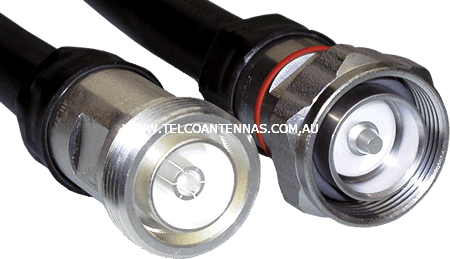
| Female 7/16 Connector | Male 7/16 Connector |
BNC
This is one of the most common antenna connectors, primarily used in VHF/UHF systems.
The 'B' in BNC refers to the bayonet twisting interface, with the female connector featuring two bayonet lugs on either side allowing connection to be achieved with only a quarter rotation.
Ideally suited to RG58/59 and subminiature cables, BNC connectors offer good performance from DC to 4GHz and have either 50Ω or 75Ω resistance.
All BNC connectors on our website are 50Ω.
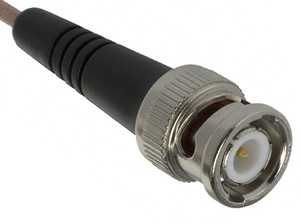 |
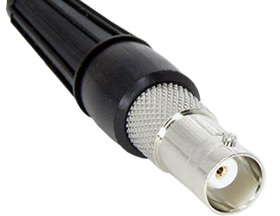 |
| Male BNC Connector | Female BNC Connector |
F Type
Primarily used for cable TV, HFC, set-top boxes, cable modems, the F coaxial connector is a 75Ω connector often used in conjunction with standard RG59 and RG6 75Ω coaxial cables.
The connector has good performance characteristics up to about 1GHz and is not suitable for modern day broadband requirements.
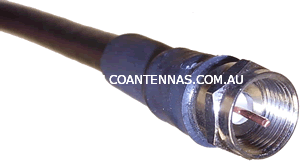 |
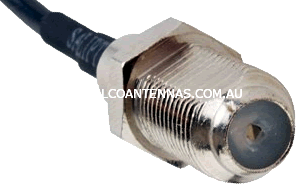 |
| Male F Connector | Female F Connector |
FME
This is the standard 50Ω connector for all mobile phone and wireless broadband antennas.
The FME connector is selected for its excellent performance in the 0-2GHz frequency range, and small connector diameter making it easy to fit in tight places.
Rarely seen in any other RF applications, the FME connector is used almost exclusively for cellular telephony and data applications.
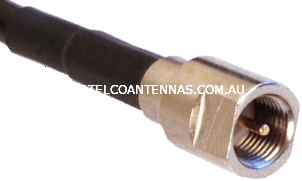 |
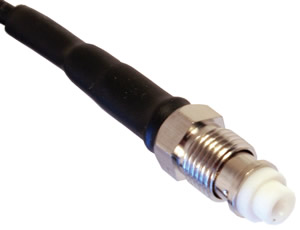 |
| Male FME Connector | Female FME Connector |
MC-Card
The MC-Card connector is a microminiature 50Ω that features snap-on mating, suitable for RF devices operating between DC and 6GHz.
This connector is often used as a substitute for MMCX in many wireless and telecom applications due to its similar performance and physical dimensions.
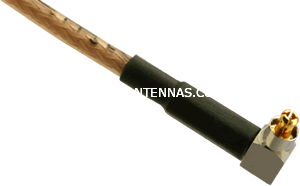 |
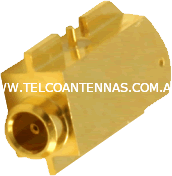 |
| Male MC-Card Connector | Female MC-Card PCB Connector |
MCX
The MCX or Micro Coaxial connector, is a 50Ω miniature coaxial connector for RF applications between DC and 6GHz.
It has identical inner contact and insulator dimensions as the more common SMB connector, but with a 30% smaller outer diameter, making it ideal for tight installations.
This connector is often used for GPS, TV tuner cards, RF hardware, and is often PCB mounted.
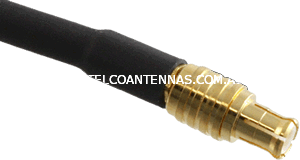 |
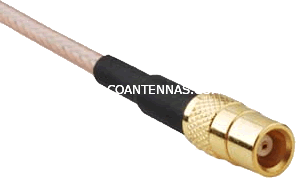 |
| Male MCX Connector | Female MCX Connector |
Mini-UHF
A minified connector based on the larger UHF connector, designed for space-limited RF applications.
Like its larger counterpart, the Mini-UHF series has a variable impedance and is suitable for transmissions between DC and 2.5GHz.
You will find this type of connector on many different RF applications, most prominently in UHF/VHF communications, where its variable impedance (around the 50Ω mark for good quality connectors) isn't as important.
 |
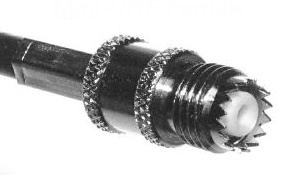 |
| Male Mini-UHF Connector | Female Mini-UHF Connector |
MMCX
The MMCX or Micro-Minature Coaxial connector, is a miniature version of the 50Ω MCX coaxial connector.
It performs well between DC to 6GHz and has a snap-lock function allowing 360 degree rotation once connected.
Most often you will see this connector PCB mounted on PCMCIA cards, modems, and GPS devices.
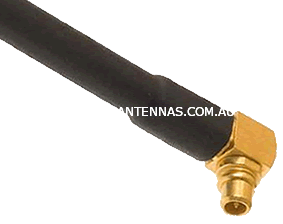 |
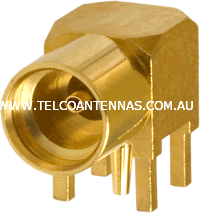 |
| Male MMCX Connector | Female MMCX Connector (PCB Bulkhead) |
N Type
N connectors are the 50Ω connector of choice for most high quality antenna systems due to their wide performance band - DC to 11GHz.
This large sized connector has a wider diameter than most connectors but is easily tightened by hand.
You will find this connector on most RF applications including radar, mobile base stations, electronic instrumentation, and of course most microwave band antennas.
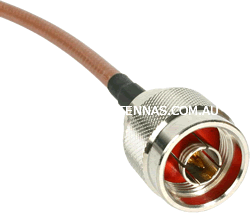 |
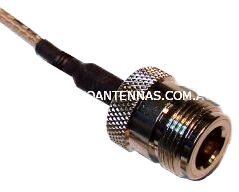 |
| Male N Connector | Female N Connector |
QMA
The QMA connector has a snap-lock mechanism designed for easier, faster and safer coupling.
Often used to replace SMA, the connector can be seen in cellular base stations and defence applications.
This 50Ω subminiature coaxial connector has a frequency range extending up to 18GHz.
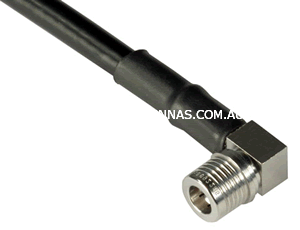 |
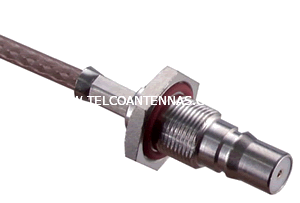 |
| Male QMA Connector | Female QMA Connector |
SMA
A smaller 50Ω connector, most often found on the back of desktop modems and as the physical interfacing screw thread of some smaller antennas.
Some antennas come pre-terminated with an SMA connector over the normal FME connector for hassle-free connecting to desktop wireless broadband modems, like the Bigpond Wireless Gateway series.
SMA is designed for a diverse range of RF applications and is suitable for communications DC to 18GHz.
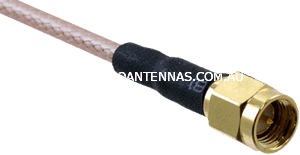 |
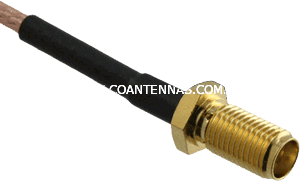 |
| Male SMA Connector | Female SMA Connector |
SMB
Similar in size and performance to the SMA connector, SMB is designed with a snap-on interfacing.
SMB connectors have a 50Ω or 75Ω impedance, and are suitable for RF applications from DC to 4GHz.
You will find SMB connectors in a wide range of areas, from telecommunications through to industrial equipment.
The gender of SMB connectors can often be confusing, as the male has the pin internally, with the female having the socket internally.
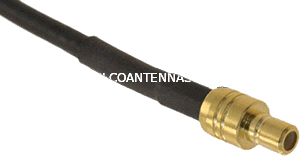 |
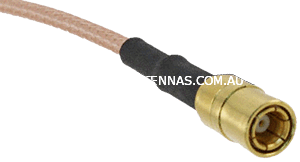 |
| Male SMB Connector | Female SMB Connector |
SSMB
This connector is the subminiature version of the SMB connector.
It is a 50Ω impedance coaxial connector with good performance from DC to 12GHz.
Like its larger brother, SSMB also has a snap-on interface.
The gender of SSMB connectors can also be confusing, like the SMB connector, the male has the receptacle, and the female has the centre pin.
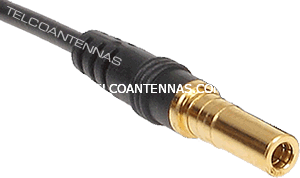 |
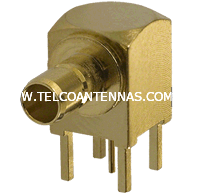 |
| Male SSMB Connector | Female SSMB Connector |
TNC
It is identical to the BNC design, but has a threaded connector.
Operates better than the BNC connector at microwave frequencies.
TNC are miniature, threaded weatherproof units with a constant 50Ω impedance, and operate from DC to 11 GHz.
Widely used in WiFi equipment, radar, and military/aerospace systems.
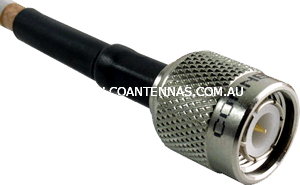 |
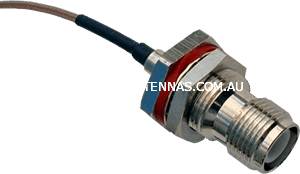 |
| Male TNC Connector | Female TNC Bulkhead Connector |
UHF
The UHF series are variable impedance connectors for low frequency operations 600KHz to 300MHz.
This very large connector is used almost exclusively for radio and UHF applications.
The low cost design of UHF connectors often results in impedance varying between 30-40Ω causing significant reflections above 300MHz. Despite this, the connector remains popular with CB/UHF (477MHz) users.
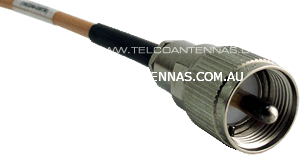 |
 |
| Male UHF (PL259) Connector | Female UHF (SO239) Panel Mount Connector |
